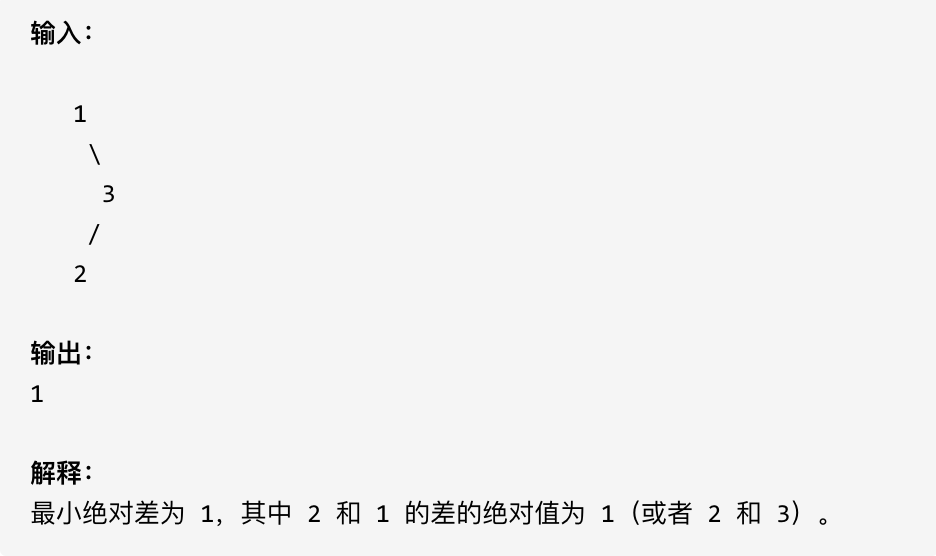530.二叉搜索树的最小绝对差 🌟
力扣链接 🌟
题目描述
给你一棵所有节点为非负值的二叉搜索树,请你计算树中任意两节点的差的绝对值的最小值。
示例 :

解题思路
- 利用中序遍历,得到一个有序数组
- 求有序数组,相邻元素的最小差值
时间复杂度和空间复杂度都是 O(n)
优化: 不需要存储整个数组,而是在中序遍历的过程中,记录前一个节点的值,然后每次计算当前节点与前一个节点的差值,并维护一个最小值
递归
递归三部曲:
明确递归函数的参数和返回值
- 参数 1:根节点
- 返回值:不需要返回值,实时更新最小值
明确终止条件
- 节点不存在时,终止
确定单层递归逻辑
递归左子树
处理中间节点逻辑
// 前一个节点值 if (prev) { minDiff = Math.min(minDiff, node.val - prev) } prev = node.val递归右子树
function getMinimumDifference(root) {
let minDiff = Infinity
let prev = null
const traverse = (root) => {
if (!root) return
traverse(root.left)
if (prev) minDiff = Math.min(minDiff, root.val - prev.val)
prev = root
traverse(root.right)
}
traverse(root)
return minDiff
}
迭代
- 初始化战,先将所有左子节点入栈
- 依次弹出节点处理,处理完当前节点后转向右子树
- 同样维护 prev 和 minDiff,实时计算相邻节点差值
var getMinimumDifference = function (root) {
let stack = []
let curr = root
let prev = null
let minDiff = Infinity
while (curr || stack.length) {
while (curr) {
stack.push(curr)
curr = curr.left
}
curr = stack.pop()
if (prev !== null) {
minDiff = Math.min(minDiff, curr.val - prev)
}
prev = curr.val
curr = curr.right
}
return minDiff
}
501.二叉搜索树中的众数 🌟
力扣链接 🌟
题目描述
给定一个有相同值的二叉搜索树(BST),找出 BST 中的所有众数(出现频率最高的元素)。
假定 BST 有如下定义:
- 结点左子树中所含结点的值小于等于当前结点的值
- 结点右子树中所含结点的值大于等于当前结点的值
- 左子树和右子树都是二叉搜索树
例如:
给定 BST [1,null,2,2],
// 1
// \
// 2
// /
// 2
返回[2].
提示:如果众数超过 1 个,不需考虑输出顺序
进阶:你可以不使用额外的空间吗?(假设由递归产生的隐式调用栈的开销不被计算在内)
解题思路
递归
如果不是二叉搜索树,遍历树节点,用 map 统计频率
如果是二叉搜索树,中序遍历时统计当前值的出现次数,每访问一个节点,比较节点值和 currentVal。如果相同,currentCount 加 1;否则,重置 currentVal 和 currentCount 为 1
递归三部曲:
确定递归函数的参数和返回值
- 参数:根节点
- 返回值:不需要
确定终止条件
遇到空节点返回
if (!root) return确定单层递归逻辑
- 递归处理左子树
- 中间节点处理逻辑
- 当前值 currentVal 等于 root.val 时,当前节点的频率 currentCount++
- 否则重置 currentCount=1,currentVal=root.val
- 比较当前节点的频率和最大频率 maxCount
- 相同,将当前节点加入结果数组;
- 大于最大频率,更新最大频率和结果数组
- 递归处理右子树
function findMode(root) {
let maxCount = 0
let result = []
let currentVal = null
let currentCount = 0
const inOrderTraverse = (root) => {
if (!root) return
inOrderTraverse(root.left)
if (node.val === currentVal) {
currentCount++
} else {
currentVal = node.val // 发现新数值
currentCount = 1 // 重置计数器
}
if (currentCount > maxCount) {
maxCount = currentCount // 刷新最高纪录
result = [currentVal] // 清空旧结果
} else if (currentCount === maxCount) {
result.push(currentVal) // 并列众数加入
}
inOrderTraverse(root.right)
}
inOrderTraverse(root)
return result
}
迭代
const findMode = function (root) {
let currentVal = null
let currentCount = 0
let maxCount = 0
let result = []
const stack = []
let node = root
while (node || stack.length) {
// 深入左子树
while (node) {
stack.push(node)
node = node.left
}
node = stack.pop() // 取出当前节点
// 统计频率
if (node.val === currentVal) {
currentCount++
} else {
currentVal = node.val
currentCount = 1
}
// 更新结果
if (currentCount > maxCount) {
maxCount = currentCount
result = [currentVal]
} else if (currentCount === maxCount) {
result.push(currentVal)
}
// 转向右子树
node = node.right
}
return result
}
236. 二叉树的最近公共祖先 🌟🌟
力扣链接 🌟🌟
题目描述
给定一个二叉树, 找到该树中两个指定节点的最近公共祖先。
百度百科中最近公共祖先的定义为:“对于有根树 T 的两个结点 p、q,最近公共祖先表示为一个结点 x,满足 x 是 p、q 的祖先且 x 的深度尽可能大(一个节点也可以是它自己的祖先)。”
例如,给定如下二叉树: root = [3,5,1,6,2,0,8,null,null,7,4]
示例:
// 3
// / \
// 5 1
// / \ / \
// 6 2 0 8
// / \
// 7 4
示例 1: 输入: root = [3,5,1,6,2,0,8,null,null,7,4], p = 5, q = 1 输出: 3 解释: 节点 5 和节点 1 的最近公共祖先是节点 3。
示例 2: 输入: root = [3,5,1,6,2,0,8,null,null,7,4], p = 5, q = 4 输出: 5 解释: 节点 5 和节点 4 的最近公共祖先是节点 5。因为根据定义最近公共祖先节点可以为节点本身。
说明:
- 所有节点的值都是唯一的。
- p、q 为不同节点且均存在于给定的二叉树中
解题思路
二叉树中两个节点的公共祖先可能有多个(比如,根节点肯定是所有节点的公共祖先。),但最近的那个就是离他们最近的共同父节点。
采用后序遍历
递归
递归三部曲:
确定递归函数的参数和返回值
- 参数 1:根节点
- 参数 2:p
- 参数 3:q
- 返回值:找到 p 或 q 就返回
确定终止条件
如果 root 为 null 或者找到数值了,返回 root
if (!root || node === q || root === p) return root确定单层递归逻辑
- 递归遍历左子树
- 递归遍历右子树
- 处理中间逻辑
- 如果左右都不为 null,则说明 q 和 p 分别在左子树和右子树中找到了,当前 root 节点就是要找的最近公共祖先
- 如果单侧找到目标,则返回找到结果
const lowestCommonAncestor = function (root, p, q) {
// 递归终止条件:空节点或找到目标节点
if (!root || root === p || root === q) return root
// 递归查找左右子树
const left = lowestCommonAncestor(root.left, p, q)
const right = lowestCommonAncestor(root.right, p, q)
// 情况判断
if (left && right) return root // 当前节点为LCA
return left || right // 返回非空子节点
}
京ICP备2022027737号
Copyright © 2022 - present @wangxiang